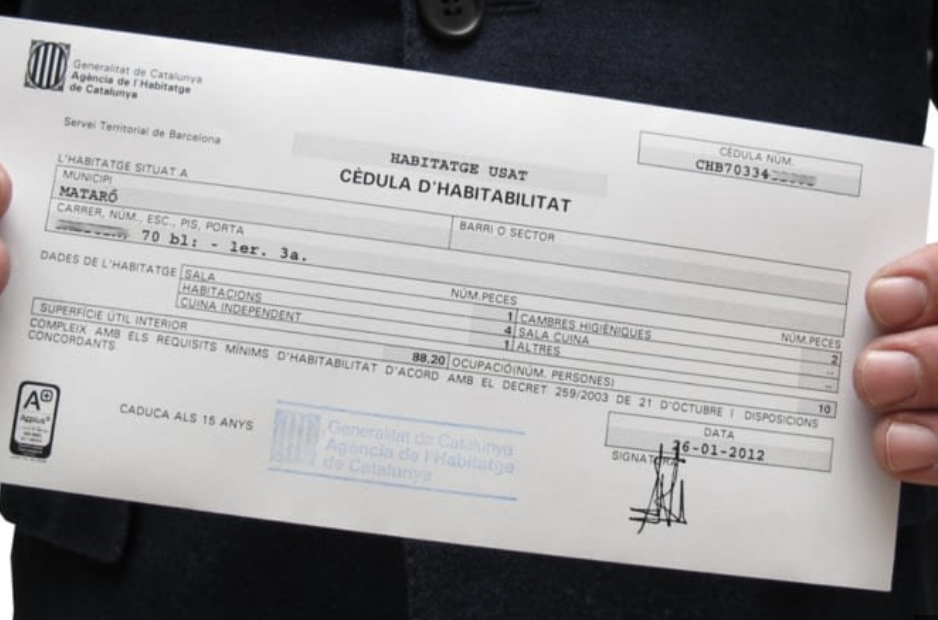In Spain, the cédula de habitabilidad is a certificate required to guarantee that a property meets the minimum safety, health, and hygiene standards to be habitable. These standards include:
- A minimum habitable surface area (36 m2 in Catalonia, for example, but this depends on the autonomous community in which the property is located)
- Sufficient ceiling height (2.5 m most of the time)
- Adequate ventilation
- Basic equipment such as a bathroom and a kitchen.
Usefulness of the cédula de habitabilidad
It protects the occupant of a property and is essential for:
- Guaranteeing legal compliance: the cédula de habitabilidad certifies that the property complies with the minimum habitability standards defined by law.
- Occupying, selling, or renting a property.
- Subscribing to essential services such as water, electricity, or gas.
- Obtaining a loan: Spanish banks sometimes require a cédula to ensure that the property is in compliance before granting the loan.
Types of cédulas de habitabilidad
There are three types of cédulas de habitabilidad:
- The cédula de primera ocupación is issued by town halls for new dwellings.
- The cédula de primera ocupación después de reforma is required for properties that have undergone a complete renovation or a change of use.
- The cédula de segunda ocupación: cédulas have a limited validity period, so you must renew your certificate to be in compliance.
Validity period of the cédula de habitabilidad
The validity period depends on the date of issue of the cédula and the autonomous community in which the property is located.
For example, note that:
- Before 2004, cédulas were valid for 10 years, so they all expired at the end of 2024.
- Between 2004 and 2012, the cédulas were valid for 15 years.
- Since 2012, they have been valid for 25 years.
Cost of a cédula
The price of a cédula de habitabilidad depends on several factors, such as the size, address and condition of the property. Overall, the final cost includes:
- The architect's technical report, for which you have to spend between €100 and €1000 depending on the type of property (apartment, house, commercial premises), its size and its location (an expert will cost more in Barcelona than in a small town in the center of the country, for example).
- Administrative fees, which range from €50 to €100 depending on the autonomous community.
Procedure for obtaining the cédula de habitabilidad
- Contact a professional: it is an architect or a technical architect (el aparejador in Spanish) who has the skills to assess the property and provide the technical certificate.
- Compile the file: the professional gathers the necessary documents: the technical certificate, the plans of the property, the cadastral information.
- Submission of application: the application must be submitted to the town hall's planning department.
- Payment of the tax: the tax varies depending on the region, and can reach around one hundred euros.
Advice from Terreta Spain experts
- Always check if the property has a cédula that is currently valid before committing to a real estate transaction.
- If you buy an old property without a cédula de habitabilidad, expect additional costs to bring it up to standard.
FAQ: The cédula de habitabilidad
What criteria are evaluated to obtain the cédula?
The criteria vary slightly from region to region, but generally include:
– The minimum habitable surface area.
– The minimum ceiling height.
– Sufficient ventilation and natural light.
– The presence of essential equipment such as a kitchen, a bathroom with WC and compliant electrical installations.
What happens if my property does not meet the criteria?
If the property does not meet the minimum requirements, you will have to carry out work to bring it up to standard before you can obtain the cédula.
Is the cédula de habitabilidad required in all regions of Spain?
Yes, but each autonomous community applies its own specific rules and criteria.
How much does it cost to obtain the cédula?
The total cost includes:
– The fees of the professional who carries out the inspection (approximately 100 to 1000 euros).
– The administrative fees for submitting the application (50 to 100 euros depending on the region).
Can I sell or rent without a cédula?
No, except for very limited exceptions (for example, if the property is sold as uninhabitable). However, this can significantly reduce the value of the property and complicate the administrative procedures.
Is the cédula de habitabilidad required for old dwellings?
Yes, even for old dwellings that have been inhabited for a long time. If it has expired or has never been issued, it will be necessary to apply for one.
What is the difference between the cédula de habitabilidad and the energy performance certificate?
– The cédula de habitabilidad certifies that the dwelling complies with the minimum habitability standards.
– The energy performance certificate assesses the energy efficiency of the dwelling (rating from A to G). These two documents are often requested together during a sale or rental.
What should I do if I lose my cédula?
You can request a duplicate from the competent administrative services in your region.
Conclusion
The cédula de habitabilidad is a key certificate to ensure that your dwelling complies with the legal standards in force in Spain. Make sure it is always up to date to avoid legal or administrative problems.
Sources: Idealista







